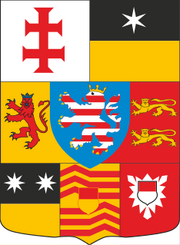
Coat of arms of Hesse-Kassel.
The Landgraviate of Hessen-Kassel or Hesse-Cassel was a reichsfreie principality of the Holy Roman Empire that came into existence when the Landgraviate of Hesse was divided in 1567 upon the death of Philip I, Landgrave of Hesse.
Since the early years of the Reformation the House of Hesse was clearly Protestant, with only a few exceptions. Landgraves Philip I, William V, and Maurice married descendants of King George of Bohemia. From William VI onwards, mothers of the heads of Hesse-Kassel were always descended from William the Silent, the leader of the Dutch to independence on basis of Calvinism.
The Landgraviate of Hesse-Kassel expanded in 1604 when Maurice, Landgrave of Hesse-Kassel, inherited the Landgraviate of Hesse-Marburg from his childless uncle, Louis IV, Landgrave of Hesse-Marburg (1537–1604).
During the Thirty Years' War, Calvinist Hesse-Kassel proved to be Sweden's most loyal German ally. Landgrave William V and, after his death in 1637, his widow Amelia of Hanau, a granddaughter of William the Silent, as regent supported the Protestant cause and the French and Swedes throughout the war and maintained an army, garrisoning many strongholds, while Hesse-Kassel itself was occupied by Imperial troops.
Hesse-Kassel in 1632[]
Hesse-Kassel was governed by Landgrave Wilhelm V at the time of the Ring of Fire. Despite the upheaval created by Grantville, William, an early supporter of Gustavus Adolphus, was able to keep Hesse-Kassel.
Hesse-Kassel was part of the Confederated Principalities of Europe, and later, of the United States of Europe.